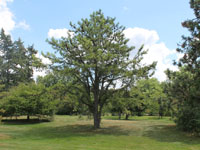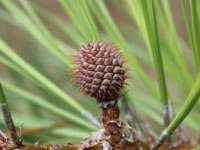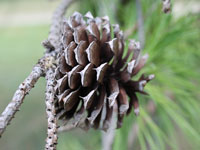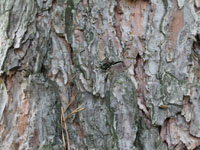![]()
Pitch Pine is a small to medium-sized species of hard pine, native to eastern North America. It is known for its toughness and adaptability, often thriving in harsh conditions where few other trees can survive. Pitch Pine frequently hybridizes with related species, including loblolly pine, shortleaf pine, and pond pine, which contributes to its genetic diversity. This resilient tree is predominantly found in the southern portions of the northeastern United States, with a range extending from coastal Maine and Ohio, southward through Kentucky and into northern Georgia. Isolated populations also occur in southern Quebec and Ontario, representing the northern edge of its natural distribution.
Pitch Pine is highly adaptable and occupies a wide range of habitats. It grows in dry, acidic, sandy uplands as well as in moist, swampy lowlands. Despite the nutrient-poor nature of many of these environments, it can flourish where other species might fail. One of the most notable regions where Pitch Pine dominates is the New Jersey Pine Barrens, where it is the primary tree species. Ecologically, Pitch Pine is an important component of fire-dependent ecosystems. It has evolved traits such as thick bark and the ability to resprout from the base after fire, allowing it to survive and regenerate in areas prone to frequent wildfires. The scientific name of Pitch Pine is Pinus rigida. The genus name Pinus is Latin for “pine,” while the species name rigida means “rigid,” a reference to the tree’s tough, durable wood and overall hardiness.
![]()
Pitch Pine is primarily harvested for rough lumber and pulpwood, serving a variety of industrial and commercial purposes. Its wood is coarse-grained, heavy, and resinous, making it less suitable for fine woodworking but well-suited for structural and utility applications. The high resin content of Pitch Pine gives the wood a natural resistance to decay and insect damage, which has historically made it valuable for railroad ties, mine timbers, fencing, and outdoor construction.
In addition to its use in construction, Pitch Pine is a significant source of pulpwood for the paper industry, where its fibrous wood is processed into pulp to manufacture various grades of paper products. In earlier times, its abundant resin was also tapped to produce naval stores, including tar, pitch, turpentine, and rosin, which were essential materials for waterproofing ships and maintaining wooden vessels. While it is not typically used for high-end lumber products due to its irregular grain and knots, Pitch Pine remains an important resource in regions where it is abundant, particularly for low-cost, utilitarian wood products and paper production.
![]() Within the realm of rational and holistic medicine, pitch pine was not used as a source of food or medicine. The principle historic use of pitch pine was for the a major source of pitch and timber for ship building, mine timbers, and railroad ties because the wood's high resin content preserves it from decay. Pitch Pine resin was also a major source for the manufacture of turpentine.
Within the realm of rational and holistic medicine, pitch pine was not used as a source of food or medicine. The principle historic use of pitch pine was for the a major source of pitch and timber for ship building, mine timbers, and railroad ties because the wood's high resin content preserves it from decay. Pitch Pine resin was also a major source for the manufacture of turpentine.
Please note that MIROFOSS does not suggest in any way that plants should be used in place of proper medical and psychological care. This information is provided here as a reference only.
![]()
There is currently no information on the edibility of the bark, seeds, needles, roots, or sap from the pitch pine tree.
Please note that MIROFOSS can not take any responsibility for any adverse effects from the consumption of plant species which are found in the wild. This information is provided here as a reference only.
![]()
Pitch Pine is a highly adaptable species that thrives in a variety of challenging environments. It is most commonly found in shallow, sandy, or gravelly soils, particularly along ridges, rocky uplands, and mountainous terrain. However, its range of habitats is not limited to high ground; Pitch Pine also grows in valleys and swamplands, provided that the soil is reasonably well-drained. Although it can tolerate moist or even seasonally wet conditions, the species does not thrive in standing water or poorly aerated soils.
One of the most distinctive characteristics of Pitch Pine is its ability to survive and grow in environments considered unsuitable for many other tree species. It frequently colonizes areas with low soil fertility and can tolerate soils with high trace levels of aluminum, which can be toxic to less resilient plants. This tolerance gives it a competitive edge in nutrient-poor or acidic conditions. Pitch Pine is well-suited to a wide range of soil textures, including light (sandy), rocky (silty), medium (loamy), and even heavy (clay) soils. Its adaptability to different substrates, along with its rugged growth habit, makes it a dominant species in several marginal ecosystems.
Perhaps most notably, Pitch Pine has evolved a suite of fire-adaptive traits that enable it to establish, persist, and regenerate in fire-prone landscapes. These adaptations include thick bark, the ability to resprout from the base or trunk after fire, and serotinous cones that open only in the heat of a fire to release seeds. As a result, Pitch Pine is often described as being dependent on periodic fire to maintain its ecological niche. It plays a crucial role in fire-dependent ecosystems, such as those found in the New Jersey Pine Barrens, where it is often the dominant tree species.
| Soil Conditions | |
| Soil Moisture | |
| Sunlight | |
| Notes: |
![]()
Pitch Pine is a long-lived and resilient conifer, with a typical lifespan of approximately 200 years. Over that time, it can reach a mature height of 15 to 18 meters (roughly 50 to 60 feet), although growth rates and final size can vary depending on environmental conditions. The needles of Pitch Pine are a distinguishing feature. They grow in fascicles (bundles) of three and range from 7.5 to 13 centimeters (3 to 5 inches) in length. Each needle is relatively thick—over 1 millimeter in diameter—and usually straight, though some may appear slightly twisted. These robust needles contribute to the tree’s ability to survive in dry or nutrient-poor soils.
The seed cones are egg-shaped, measuring 3 to 7 centimeters in length (1.2 to 2.8 inches), and are armed with stiff prickles on the scale tips. These cones typically require two years to fully mature, after which they release seeds gradually over the fall and winter. Importantly, Pitch Pine is not self-pollinating, which helps maintain genetic diversity among populations.
One of the most remarkable traits of Pitch Pine is its exceptionally high regenerative capacity. If the main trunk is damaged, whether by cutting, storm breakage, or fire, the tree is capable of producing epicormic shoots, which sprout directly from the trunk or branches. This ability allows the tree to resprout and continue growing, even after severe damage. It’s a critical survival strategy in fire-prone ecosystems, where it is not uncommon to see burnt trees regenerate into multi-trunked, twisted forms. This unusual growth habit has also made Pitch Pine a popular species in the art of bonsai, prized for its rugged appearance and resilience.
In terms of growth rate, young Pitch Pines are relatively fast-growing, adding about 30 centimeters (1 foot) of height per year under optimal conditions. This growth continues steadily until the tree reaches about 50 to 60 years of age, after which the rate of growth slows significantly. By the time the tree reaches 90 years, annual height gain becomes minimal, and most of the tree's energy is redirected to maintaining its structure and reproduction. Reproduction begins early in trees that grow in open, sunlit conditions, with some producing cones in as little as three years. Trees growing in shadier, more crowded environments tend to begin reproduction a few years later. Once cones are mature, the seeds are dispersed largely by wind, taking advantage of the tree’s often elevated position in the landscape.
![]()
| Tree Height | 15m to 18m | |
| Habitat | Sands and gravel on ridges or within swamps and valleys | |
| Needle Length | 7.5cm to 13cm long | |
| Needle Grouping | Stout Bundles of Three | |
| Needle Colour | Yellow and Green | |
| Bark | Thick, Rough, and broadly furrowed into broad scaly ridges | |
| Bark Colour | Dark Gray | |
| Cone Size | 3cm to 7cm long and egg shaped | |
| Cone Colour | Yellowish Brown | |
| Pollination | Wind | |
| Tree Gender | Trees are hermaphrodite trees are not self-fertile | |
| Fruit | Small winged seeds | |
| USDA Zone | 3 (-37°C to -40°C) cold weather limit |
![]()
No known health risks have been associated with pitch pine. However ingestion of naturally occurring plants without proper identification is not recommended.
![]()
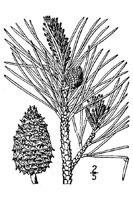 |
-Click here- or on the thumbnail image to see an artist rendering, from The United States Department of Agriculture, of pitch pine. (This image will open in a new browser tab) |
![]()
 |
-Click here- or on the thumbnail image to see a magnified view, from The United States Department of Agriculture, of the seeds created by the pitch pine tree for propagation. (This image will open in a new browser tab) |
![]()
Pitch Pine can be referenced in certain current and historical texts under the following four names:
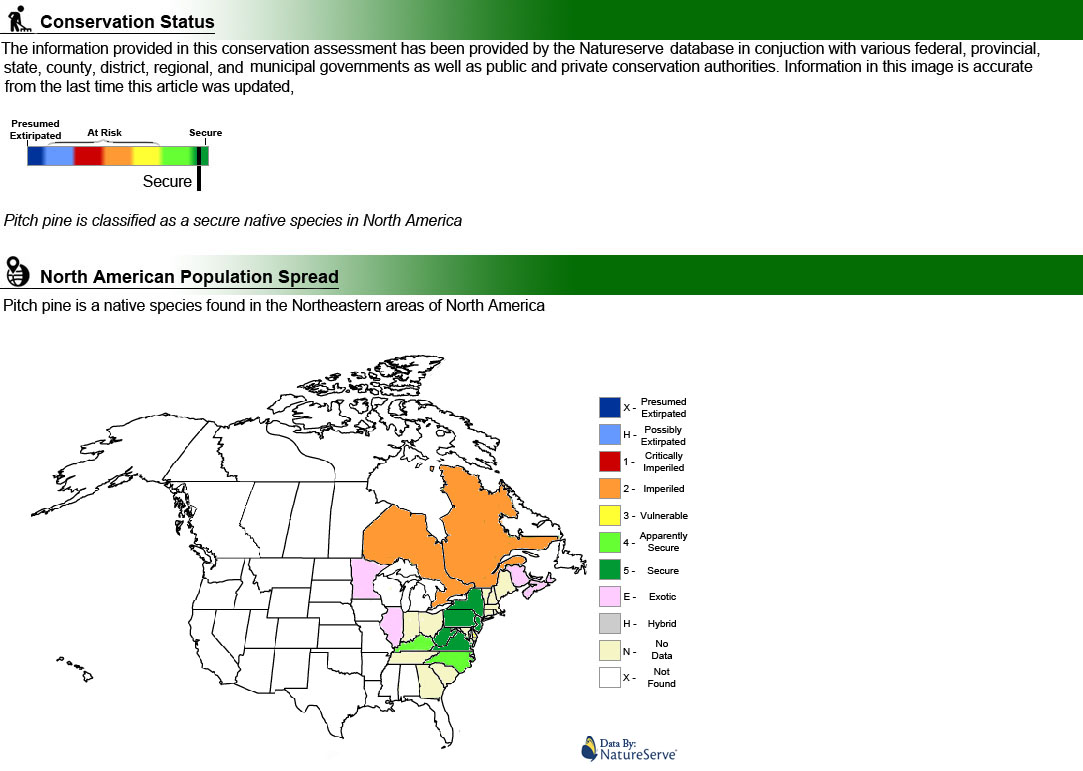
![]()
 |
What's this? What can I do with it? |
![]()
| Moore, Gerry; Kershner, Bruce et al. (2008). National Wildlife Federation Field Guide to Trees of North America. New York: Sterling. ISBN 1-4027-3875-7 | |
| Collingwood, G. H., and W. D. Brush. 1978. Knowing your trees. Rev. and ed. by D. Butcher. American Forestry Association. Washington, DC. | |
| Eyre, F. H. 1980. Forest cover types of the United States and Canada. Society of American Foresters. Washington, DC. | |
| Dickinson, R.; Royer, F.; (2014) Plants of Southern Ontario. ISBN 978-1-55105-906-8. | |
| USDA-NRCS PLANTS Database / USDA NRCS. Wetland flora: Field office illustrated guide to plant species. USDA Natural Resources Conservation Service. | |
| National Audubon Society. Field Guide To Trees (Eastern Region): Alfred A. Knopf. ISBN 0-394-50760-6 | |
| National Audubon Society. Field Guide To Trees (Eastern Region): Alfred A. Knopf. ISBN 0-394-50760-6 | |
| June 01, 2025 | The last time this page was updated |
| ©2025 MIROFOSS™ Foundation | |
 |
|

